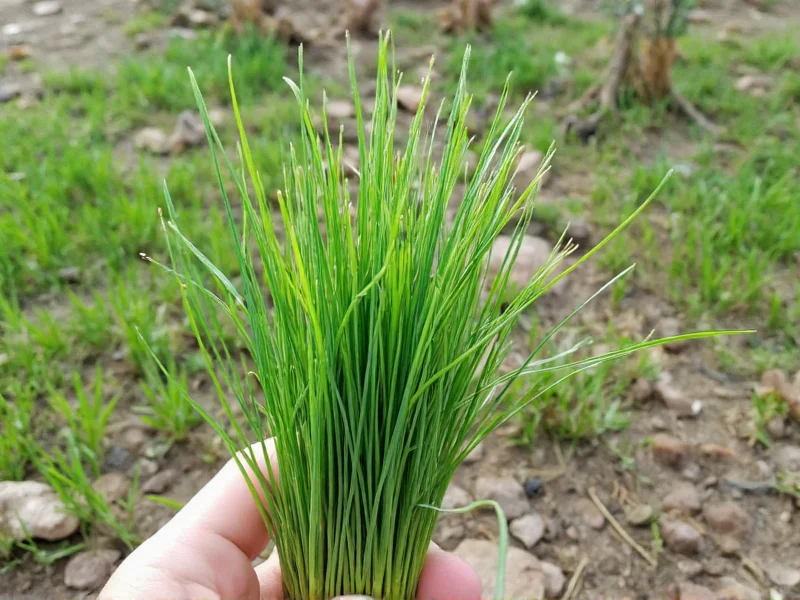Understanding Chives: Nature's Delicate Onion Relative
Chives represent one of the oldest known herbs cultivated for culinary purposes, with historical records dating back to ancient China over 5,000 years ago. These slender green stalks belong to the Allium genus, making them close relatives of onions, garlic, and leeks, yet they maintain a uniquely mild flavor profile that distinguishes them from their more pungent cousins.Botanical Classification and Characteristics
Scientifically classified as Allium schoenoprasum, chives grow in dense clumps of hollow, cylindrical stems that typically reach 12-24 inches in height. The plant produces attractive purple flower clusters that are also edible. Unlike green onions which develop a small bulb at the base, true chives maintain uniform thinness from root to tip without any bulb formation.
| Feature | Chives | Green Onions/Scallions |
|---|---|---|
| Botanical Name | Allium schoenoprasum | Allium fistulosum |
| Stem Structure | Fully hollow | Solid lower portion |
| Base Formation | No bulb | Small white bulb |
| Flavor Intensity | Mild, delicate | Stronger, more onion-like |
Chives vs Similar Allium Varieties
Many home cooks confuse chives with green onions or scallions, but several distinguishing characteristics set them apart. While green onions develop a small white bulb at their base and have a stronger onion flavor, chives maintain consistent thinness throughout their entire length with no bulb formation. Garlic chives (Allium tuberosum) represent another variety with flat leaves and a distinct garlic aroma, often used in Asian cuisine.
Culinary Applications and Flavor Profile
What do chives taste like? They offer a subtle onion flavor with delicate garlic notes, making them perfect for dishes where you want onion essence without overwhelming pungency. Professional chefs typically add chives at the very end of cooking or as a garnish since heat diminishes their delicate flavor. They complement eggs, potatoes, fish dishes, cream sauces, and salads beautifully. When properly chopped with scissors (never a knife, which crushes the delicate structure), fresh chives release their aromatic compounds without becoming bitter.
Nutritional Benefits of Chives
Nutritionally, chives pack a surprising punch despite their delicate nature. A single tablespoon (3 grams) of fresh chives contains:
- Vitamin K: 27% of the Daily Value
- Vitamin C: 4% of the Daily Value
- Vitamin A: 3% of the Daily Value
- Trace amounts of calcium, iron, and potassium
These nutritional benefits of chives make them more than just a pretty garnish—they contribute meaningful antioxidants and compounds associated with cardiovascular health.
Growing Chives at Home
One of the most appealing aspects of chives is how easily they can be grown in home gardens or containers. They thrive in USDA hardiness zones 3-9 and require minimal care once established. Gardeners who learn how to grow chives at home can enjoy a continuous harvest throughout the growing season by cutting stems 2 inches above soil level, which encourages new growth. Chives prefer full sun but tolerate partial shade and require well-draining soil. They're particularly valuable in companion planting, as their scent deters many common garden pests.
Proper Storage Techniques
Fresh chives have a relatively short shelf life compared to other herbs. To maximize freshness when storing chives:
- Wrap them loosely in a slightly damp paper towel
- Place in a perforated plastic bag in the refrigerator
- Use within 5-7 days for optimal flavor
For longer preservation, many cooks freeze chives in ice cube trays with water or oil, or dry them for use in spice blends. However, freezing better preserves their fresh flavor compared to drying.
Historical Significance and Global Use
Chives have been used culinarily since medieval times across Europe and Asia. Ancient Romans believed chives could relieve sunburn and sore eyes, while European peasants during the Middle Ages used them to ward off disease. In French cuisine, chives form one of the four essential "fines herbes" alongside tarragon, chervil, and parsley. Scandinavian cultures traditionally serve fresh chives with boiled potatoes and fish, while Chinese cuisine frequently incorporates garlic chives into stir-fries and dumplings.
Common Questions About Chives
Can you eat chive flowers?
Yes, chive flowers are completely edible and make a beautiful, flavorful addition to salads or as a garnish. The purple blossoms have a milder onion flavor than the stems and can be separated into individual florets for easier use in dishes.
How do you properly chop chives?
The best method for chopping chives involves using sharp kitchen scissors to cut them into uniform 1/4-inch pieces. Cutting with a knife can crush the delicate hollow stems and cause them to become bitter. Always wash chives gently and dry them thoroughly before cutting to prevent bruising.
Why do my chives taste bitter?
Chives develop bitterness when exposed to excessive heat, cut with a dull knife (which crushes rather than cuts the stems), or when they've begun to spoil. To prevent bitterness, add chives at the very end of cooking, use scissors for cutting, and ensure you're using fresh, vibrant green stems without yellowing or wilting.
Can you substitute green onions for chives?
While green onions can substitute for chives in some applications, they have a stronger flavor and different texture. For the closest substitution, use only the green parts of scallions and reduce the quantity by about 25% since they're more pungent. For garnishes where appearance matters, the substitution is less ideal due to the thicker texture of scallion greens.
How often can you harvest chives from a single plant?
You can safely harvest chives every 3-4 weeks during the growing season. When cutting, never remove more than one-third of the plant at once, and always cut stems at least 2 inches above the soil line to allow for regrowth. In optimal conditions, a healthy chive plant can be harvested 3-4 times per growing season.











 浙公网安备
33010002000092号
浙公网安备
33010002000092号 浙B2-20120091-4
浙B2-20120091-4